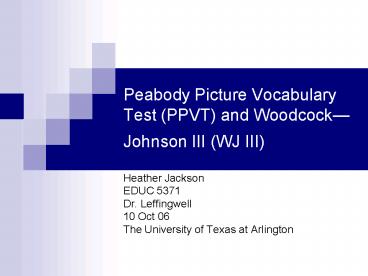Peabody Picture Vocabulary Test (PPVT) and Woodcock - PowerPoint PPT Presentation
1 / 17
Title:
Peabody Picture Vocabulary Test (PPVT) and Woodcock
Description:
Peabody Picture Vocabulary Test (PPVT) and Woodcock Johnson III (WJ III) Heather Jackson EDUC 5371 Dr. Leffingwell 10 Oct 06 The University of Texas at Arlington – PowerPoint PPT presentation
Number of Views:1053
Avg rating:3.0/5.0
Title: Peabody Picture Vocabulary Test (PPVT) and Woodcock
1
Peabody Picture Vocabulary Test (PPVT) and
WoodcockJohnson III (WJ III)
- Heather Jackson
- EDUC 5371
- Dr. Leffingwell
- 10 Oct 06
- The University of Texas at Arlington
2
Assessment is the process of gathering
information using appropriate tests, instruments,
and techniques (Johnsen, Identifying Gifted
Students, vii).
- Peabody Picture Vocabulary Test (PPVT)
- Application to classroom
- WoodcockJohnson III Test (WJ III)
- Application to classroom
3
PPVT
- Developed and first published in 1959 by Loyd and
Leota Dunn. - Updated three times to PPVT III in 1997.
- Published by American GuidanceService, Inc
(AGS). - 2001 price 239.95 for all testing materials
plus 149.95 for ASSIST computer software. - Ages two to ninety, but recommends two to forty.
4
PPVT
- Designed to measure receptive vocabulary
attainment for Standard English and can also be
used as a screening test of verbal ability in
language (Bessai, MMY, 14).
- Measures the comprehension of spoken English and
only the listening vocabulary which is a more
restricted aspect of overall linguistic and
cognitive functioning.
5
Weaknesses
- MeriamWebsters Collegiate Dictionarylimited
word choice - Can use only words which meanings can be clearly
illustrated by black-and-white line drawings
- Began with 600 words and are currently at a
sparing 144.
6
Strengths
- Computer system pulls words from the
dictionarysaves time. - No test items contain racial, ethnic, or gender
biases.
- Updated continuously to coincide with more modern
vocabulary. - Closely correlates to the Wechsler Intelligence
Scale for ChildrenThird Edition (WISCIII).
7
- Wechsler says that, expanded and comprehensive
vocabulary ensures success in all areas of
achievement, not just English/Language Arts and
that of all the batteries of intelligence tests
vocabulary correlates more highly with full scale
IQ scores more than any other subtest (1974, p.
47).
8
PPVT Application to classroom
- School diversityextremely mixed of all races and
ethnicities with no clear majority. - Develop a program for all levels of vocabulary.
- Begin with easier words efficiently moving
towards more complex words.
- Offers flexibility and applicability across
curricula. - Pictures assist in deciphering words while
expanding vocabulary simultaneously.
9
WJ III
- Developed by Richard Woodcock and Mary Bonner
Johnson. - Originally titled WoodcockJohnson
Psycho-Educational Battery. - First published in 1977 and updated to WJ III
test in 1999. - Published by Riverside Publishing.
- 2002 price data 444 for complete testing
materials to include computer software or 522.50
for complete testing materials plus a leather
carrying case. - Ages two to ninety.
10
WJ III
- A comprehensive, norm referenced, individually
administered assessment of those cognitive
abilities, skills, and academic knowledge most
recognized as comprising of human intelligence,
and are routinely encountered in school and other
settings (Cizek, MMY, 15).
- One complete test with two separate batteries.
- One battery of tests measures Cognitive abilities
(WJ III COG). - One battery of tests measures general and
specific cognitive achievement (WJ III ACH).
11
Weaknesses
- Time consuming.
- Two batteries of tests each consisting of
approximately 20 to 22 subtests divided further
into ten cognitive subtests and twelve
achievement subtests.
12
Strengths
- Versatile for English Language learners.
- Appropriate key responses in both English and
Spanish - Allows administrator to print reports in both
English and Spanish.
- Academic and informal settings (E.g., college
lectures). - Has been updated twice from its original to WJ
III.
13
- Overall the test results appear high, with
magnitudes in the .80s and .90s seeming abnormal,
but all of the results appear uniform in their
scoring leading one to believe that it is a true
measure of giftedness and that this test must be
considered the premier battery for measuring both
the cognitive and school achievement of
school-aged children and young adults, and that
all other tests must emulate this one (Cizek,
MMY, 15).
14
WJ III Application to classroom
- Use to determine multiple intelligences in
various areas. - Achievement Reading, Mathematics, Written
Language and Knowledge. - Shows Scholastic and non-scholastic interest
levels.
- Students, parents, and educators may see where
childs true interests lie. - Reduced fear and anxiety about G/T measurement
test because test can be labeled as an interest
test.
15
WJ III Application to classroom Cont
- Test results can actually be sent to educators to
ensure useful material is taught rather than
boring the exceptionally gifted.
16
Bibliography
- Bessai, Fredrick. (2004). Peabody Picture
Vocabulary Test. Mental Measurements Yearbook.
(Vol. 14). Nebraska University of Nebraska. - Cizek, Gregory. (2004). WoodcockJohnson III.
Mental Measurements Yearbook. (Vol. 15).
Nebraska University of Nebraska. - Hager, Paul C. (1985). WoodcockJohnson
Psycho-Educational Battery. In Daniel J. Keyser
and Richard C. Sweetland (Eds.), Test Critiques,
Vol. IV, (pp. 683 703). Kansas City, MO
Library of Congress Cataloging in Publication
Data. - Johnsen, Susan K. (2004). Preface. In Susan K.
Johnsen (Ed.), Identifying Gifted Students a
practical guide, (pp. vii). Waco, TX Prufrock
Press, Inc. - Jolly, Jennifer L and Jennifer Robins. (2004).
Technical Information Regarding Assessment. In
Susan K. Johnsen (Ed.), Identifying Gifted
Students a practical guide, (pp. 98 99).
Waco, TX Prufrock Press, Inc. - Umberger, Forrest G. (1985). Peabody Picture
Vocabulary Test. In Daniel J. Keyser and
Richard C. Sweetland (Eds.), Test Critiques,
Vol. III, (pp. 488 495). Kansas City, MO
Library of Congress Cataloging in Publication
Data. - Wechsler, D. (1974). Preschool and Primary Scale
of Intelligence Manual. New YorkThe
Psychological Corporation.
17
(No Transcript)































